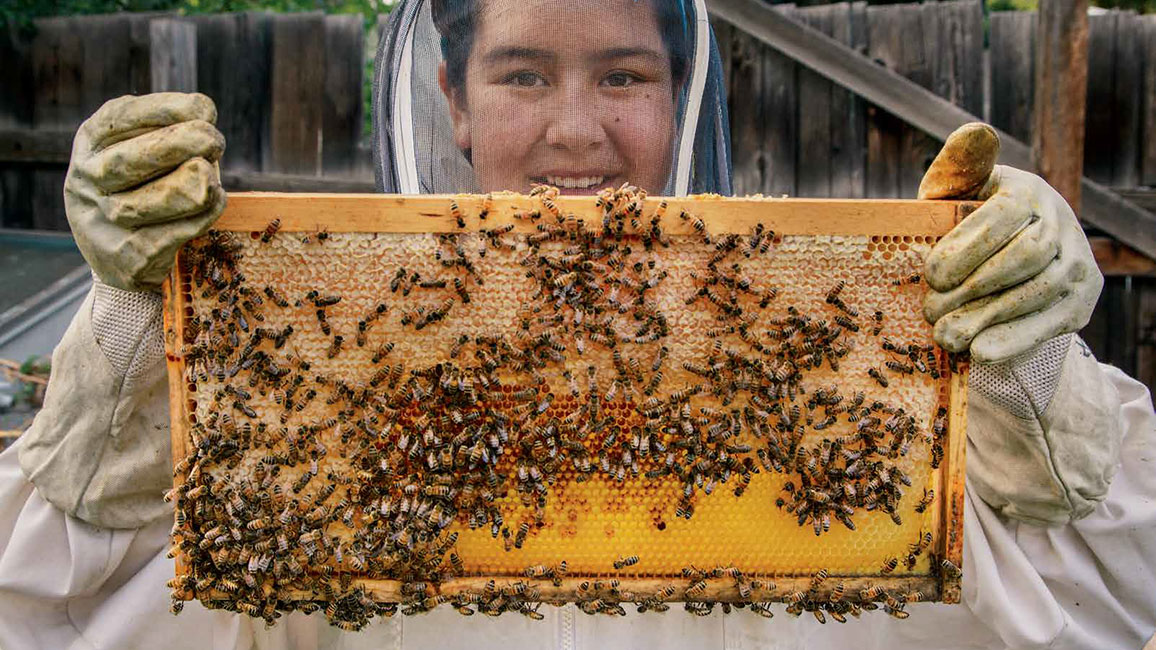
Queen Bee
By Karen McGaughey, as told to Ellen Lambeth; photos by Joanna B. PinneoMy name is Karen, and I’m here to say that bees are totally awesome!
Look at the honey bees crawling all over this thing! It’s a frame from one of my backyard bee hives. Do I look scared? No way! For one thing, I’m totally protected in my sting-proof bee suit. Besides, I’m very careful when handling bees. When I’m calm and gentle, so are the bees. As you can see, I’m actually smiling. That’s because I feel really proud. A quick look at this frame tells me that the bees in my hive are healthy and busy. Plus, I’m doing something that not many other people—especially kids—get to do. And I think that’s really cool!
A FAMILY AFFAIR
I live in Colorado with my two parents, two sisters, two cats, and two dogs. I’m on the volleyball team at school, and I play French horn in my school band. But my main claim to fame is that I’m a beekeeper! In fact, my whole family is made up of beekeepers.
My dad has been one forever. When my sisters and I were young, he used to dress us up in little bee suits and let us watch him work. We’d enter our honey and beeswax in contests at our local fair—and we’d win first place. By the time I was 5, I was hooked! Now I’m 14 and help my family take care of hives all over my community. And I have three in my backyard that I take care of by myself.
BUSY BEE-SEASON
Each hive is a stack of boxes called “supers.” Inside each super are frames like the one I’m holding on pages 30–31. The bees build their wax honeycombs on the frames. They store the honey they make in little six-sided cells in the comb. By summer’s end, we’re ready to harvest it.
After taking the lid off each hive (see photo 1), I lay a pad on the top super. The pad has been sprinkled with a scent that the bees don’t like. They move away from the smelly pad down to the bottom supers where the queen and baby bees are. Then we can grab the top ones filled with honey (2) and load them into our truck. We take them back to the “honey house” in our backyard. There, we pull out the frames (3) and start scraping off the wax (4).
SWEET IS NEAT!
The first order of business is removing the wax caps from the honey-filled cells. We melt the wax and form it into blocks to sell. People use beeswax to make candles, lip balms, and many other products.
But the yummiest part is getting the honey out of the cells. I do that by putting the frames in an extractor (5). This machine spins really fast, which extracts (removes) the honey from the frames and into the tank. (It works the same way that the spin cycle on your washing machine removes water from your clean laundry.) At the bottom of the tank is a spigot. When I open the spigot, the honey flows through a filter and into a bucket (6). The filter catches leftover bits of wax and gunk. Then I open a spigot at the bottom of the bucket to fill up jars with pure, clean honey.
BEES ON PARADE
Every summer, my family participates in a parade at our county fair. We decorate a float with our beekeeping stuff, and I get to wear my “queen bee” costume while sitting in my “flower-petal throne” (7). It’s so much fun to wave to the crowds along the streets and celebrate the importance of bees in our lives. After all, without bees, we wouldn’t have many of our favorite fruits and vegetables or beautiful flowers. As you probably know, that’s because bees spread pollen from flower to flower, which helps these plants grow.
But lately, bees in Colorado and elsewhere have been dying by the millions. One likely culprit is crop chemicals. These kill not only pests but also good insects, including bees. I want to save bees, but I can’t do it alone. You can help by not using pesticides in your yard and by buying foods made from pesticide-free crops. Here’s my mission and my motto: I speak for the bees because they can’t speak for themselves!
“Queen Bee” originally appeared in the June/July 2017 issue of Ranger Rick magazine.



















